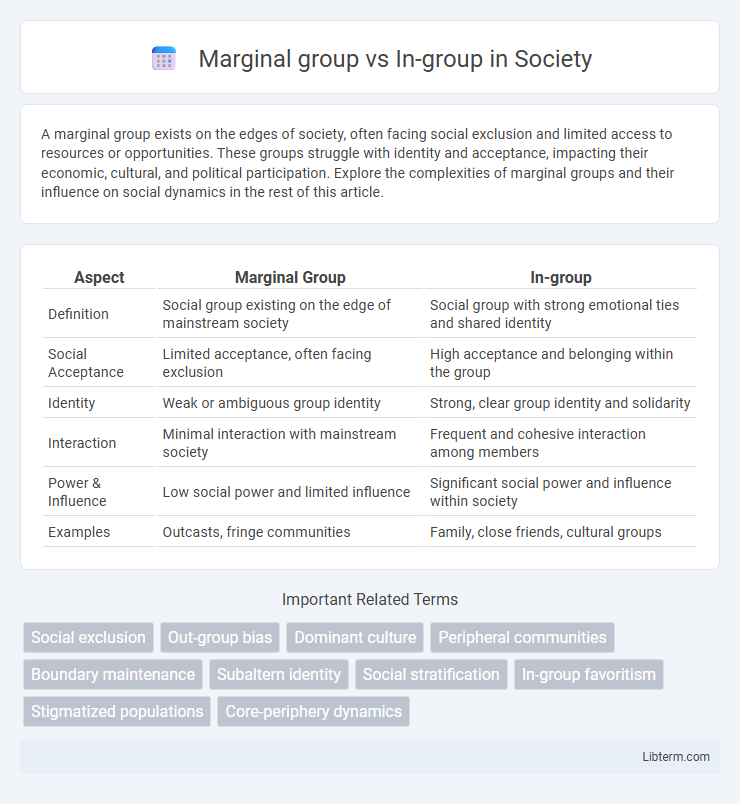A marginal group exists on the edges of society, often facing social exclusion and limited access to resources or opportunities. These groups struggle with identity and acceptance, impacting their economic, cultural, and political participation. Explore the complexities of marginal groups and their influence on social dynamics in the rest of this article.
Table of Comparison
| Aspect | Marginal Group | In-group |
|---|---|---|
| Definition | Social group existing on the edge of mainstream society | Social group with strong emotional ties and shared identity |
| Social Acceptance | Limited acceptance, often facing exclusion | High acceptance and belonging within the group |
| Identity | Weak or ambiguous group identity | Strong, clear group identity and solidarity |
| Interaction | Minimal interaction with mainstream society | Frequent and cohesive interaction among members |
| Power & Influence | Low social power and limited influence | Significant social power and influence within society |
| Examples | Outcasts, fringe communities | Family, close friends, cultural groups |
Defining Marginal Groups and In-Groups
Marginal groups consist of individuals who exist on the edges of a dominant society, often experiencing social exclusion or limited participation due to differences in culture, race, or socioeconomic status. In-groups refer to social groups where members share a strong sense of belonging, common identity, and mutual support, often leading to preferential treatment within the group. Understanding the dynamics of marginal groups versus in-groups is crucial for analyzing social cohesion, discrimination, and group identity formation.
Historical Context of Social Group Divisions
Marginal groups historically emerged as social collectives excluded from mainstream in-groups defined by ethnicity, class, or political power, often facing systemic discrimination and limited access to resources. In-groups, dominant within historical power structures, shaped social norms and hierarchies, reinforcing divisions through exclusionary practices like segregation and caste systems. These social group divisions influenced collective identities and intergroup relations, underpinning social conflicts and movements for inclusion across various societies.
Key Characteristics of Marginal Groups
Marginal groups are characterized by their limited integration and acceptance within both dominant and subordinate social groups, often experiencing social exclusion and identity conflicts. These groups typically navigate dual cultural influences while lacking full access to economic, political, or social resources available to in-groups. The key characteristics include social isolation, cultural hybridity, and ambiguous group identity, distinguishing them from in-groups that exhibit strong cohesion, clear boundaries, and shared norms.
Social Dynamics of In-Groups
In-groups create strong social bonds through shared norms, values, and identity, often leading to favoritism and exclusion of out-groups or marginal groups. Social dynamics within in-groups foster cooperation, conformity, and mutual support, reinforcing group cohesion and collective self-esteem. Marginal groups frequently experience limited access to resources and social power due to their exclusion from dominant in-group networks.
Psychological Effects of Group Belonging
Marginal groups often experience increased feelings of exclusion, leading to heightened stress and lower self-esteem compared to in-groups, which provide members with a strong sense of identity and social support. In-group belonging fosters psychological well-being by promoting acceptance, shared values, and interpersonal trust, which are crucial for mental health. Without inclusion in a core group, marginal group members can face social isolation, intensifying anxiety and diminishing overall psychological resilience.
Mechanisms of Exclusion and Inclusion
Marginal groups experience exclusion through limited access to resources, social networks, and decision-making processes, often facing systemic barriers that reinforce their peripheral status. In contrast, in-groups maintain inclusion by fostering shared identities, mutual obligations, and preferential treatment, which strengthen internal cohesion and resource exchange. Mechanisms such as social norms, gatekeeping, and implicit biases actively perpetuate group boundaries, influencing individuals' sense of belonging and participation within social structures.
Impacts of Marginalization on Individuals
Marginal groups experience social exclusion and limited access to resources, which leads to diminished self-esteem, reduced opportunities, and increased stress levels in individuals. In contrast, members of in-groups benefit from social support, affirmation, and greater access to power, fostering a stronger sense of identity and belonging. The psychological impact of marginalization often results in feelings of isolation, depression, and decreased overall well-being.
Stereotypes and Social Stigmatization
Marginal groups often face pervasive social stigmatization and negative stereotypes that reinforce exclusion and limit access to resources, contrasting with in-groups that typically benefit from positive stereotyping and social acceptance. Stereotypes about marginal groups can include assumptions about inferiority, deviance, or lack of competence, which contribute to systemic discrimination and social isolation. In-group members usually perpetuate these stereotypes, maintaining social hierarchies and boundaries that protect their privileged status while marginalizing others.
Bridging the Gap: Promoting Social Cohesion
Marginal groups often face social exclusion and limited access to resources, while in-groups benefit from established networks and shared identities that strengthen social bonds. Bridging the gap between marginal groups and in-groups involves creating inclusive policies, fostering intercultural dialogue, and encouraging community engagement to promote mutual understanding. Social cohesion increases when diverse groups collaborate, reducing prejudice and building a more equitable society.
Future Perspectives on Group Integration
Marginal groups often face systemic barriers to full inclusion, which challenges social cohesion and equality in future group integration efforts. In-groups typically benefit from established networks and resource access, making their integration processes smoother and more influential in shaping collective goals. Future perspectives emphasize creating equitable frameworks that promote cross-group interactions, reducing marginalization and fostering inclusive environments in diverse social and organizational settings.
Marginal group Infographic

 libterm.com
libterm.com